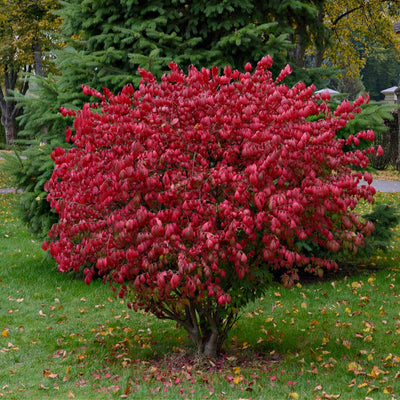Roughleaf Dogwood Characteristics
Rough leaf Dogwood: Characteristics, Uses, and Landscaping
Cornus drummondii is a native North American deciduous plant grown in hardiness zones 4-9. It is a perennial and reaches up to 25 feet in height and 10-15 feet in width. The common name of Roughleaf Dogwood, or rough-leaved dogwood, comes from the rough texture of its leaves. Further adding to this unique feature, the leaves are also covered in hair and have 3 to 5 lateral veins curving outwards. The edges are smooth, and the veins remain intact even if the leaf is ripped apart. The bark is also slightly rough, growing in long plates with grey coloring. Foliage is somewhat shiny green, turning purple and red in fall. Immature twigs are thin with a brown or grayish-red color and turn completely grey as they age.
From May to June, light cream-colored flowers appear on the plant in clusters that can be 3 inches wide. The individual flowers themselves are 1/4 inch wide and have four petals and stamens. They also have one stylus and pistil apiece. White fruit about .5 inches in diameter follows the flowers from August to October. The fruit is beloved by wildlife, and fruit droppings are not very problematic.
Rough-leaf Dogwood grows relatively fast and is a very hardy plant. It prefers moist soil but will grow in dry soil if deeply planted. This plant can live in soil containing loam or clay. It also does not matter if said soil is alkaline, acidic, sandy, or well-drained. Rough-leaf Dogwood has a high drought tolerance, making it ideal for areas with less water. It can be grown in partial shade, but more sun is preferable for improved flowering and fruit production. In the wild, it grows near creeks, in woods, and in thickets. As mentioned earlier, wildlife (mainly birds) love the fruit, so it does not last long.
The spread of these plants is up to fifteen feet and is very dense. The high density makes Rough-leaf dogwood an excellent choice for hedges and borders. It also makes a beautiful understory candidate. Even though the plant is considered closer to a shrub, it can be trained to be a small tree.
Besides being an excellent choice for decorating, this deciduous plant also has some practical uses. Rough-leaf Dogwood is excellent for stabilizing soil, particularly near water sources. That is understandable, considering some of their natural habitats include creek areas. Another use is to attract wildlife and help with improving habitats. While other animals are known to eat from the plant, birds love the fruit. Because of this, Roughleaf dogwood provides sustenance and a home for birds. At least forty species eat its fruit, so no matter the zone it is planted in, some bird activity can be expected, especially during the fall season when the fruit ripens.
When using this plant in landscaping, remember that it can grow to several trunks, but little training can be made to grow only one. There are many benefits to using Roughleaf dogwood in landscaping; as explained above, many are practical. Due to the ease of growing the plant in multiple environments, the dogwood’s placement is mainly up to what effect is wanted and what it will be used for. For example, it can add beauty and attract birds along a driveway or recreational area. Rough leaf Dogwood is one of the most attractive and valuable Cornus(Dogwood) family types.
#Roughleaf Dogwood #Dogwood #landscaping ideas #trees #tn nursery #wholesale nursery co #tennessee wholesale nursery #online plant nursery
Overview and Identification
Cornus drummondii, commonly known as Roughleaf Dogwood, is a small to medium-sized deciduous tree or shrub native to North America. This member of the Cornaceae family is easily recognizable by its rough-textured leaves and showy, creamy white flowers. Often found in dense thickets, Roughleaf Dogwood is popular for hedges, borders, and wildlife cover. Its intertwined branches create a natural habitat for various bird species, making it a valuable addition to any landscape.
Physical Characteristics
Roughleaf Dogwood boasts several distinctive physical traits that make it stand out. The leaves, ranging from 1 to 5 inches long, are olive green on the upper surface and paler underneath. True to its name, the leaves have an unmistakable rough texture. The plant’s stems are a striking reddish-brown, while the bark is gray and slightly rough. From August to October, Roughleaf Dogwood produces small, round white fruits, a crucial food source for many birds and small mammals.
Growth Habit and Landscape Uses
Roughleaf Dogwood is a versatile plant that thrives in various landscape settings. It is ideal for use as a hedge, border, or wildlife cover, and can also serve as a specimen plant or in naturalized areas. This hardy plant prefers full sun to partial shade and well-drained soils, making it an excellent choice for areas with poor soil conditions. Its high drought tolerance allows it to flourish even in regions with low rainfall, adding beauty and ecological value to any garden.
Care and Maintenance
Roughleaf Dogwood is a low-maintenance plant that requires minimal care, making it a favorite among gardeners. Regular watering is essential, although the plant can withstand some drought. Pruning should be done regularly to maintain its shape and encourage healthy growth. Removing any dead or diseased branches is crucial to prevent the spread of disease. While Roughleaf Dogwood is generally resilient, it can be susceptible to pests and diseases like leaf spot and twig blight, so regular monitoring is recommended.
Propagation and Cultivation
Propagating Roughleaf Dogwood can be achieved through various methods, including seed, softwood cuttings, and division. Growing from seed can be slow and unpredictable, but softwood cuttings taken in spring or summer offer a more reliable option. Division is another effective method, best done in the fall or early spring. Roughleaf Dogwood adapts well to different soil types but thrives in well-drained soils with full sun to partial shade. With the right care, this adaptable plant can enhance any landscape with its beauty and ecological benefits.

